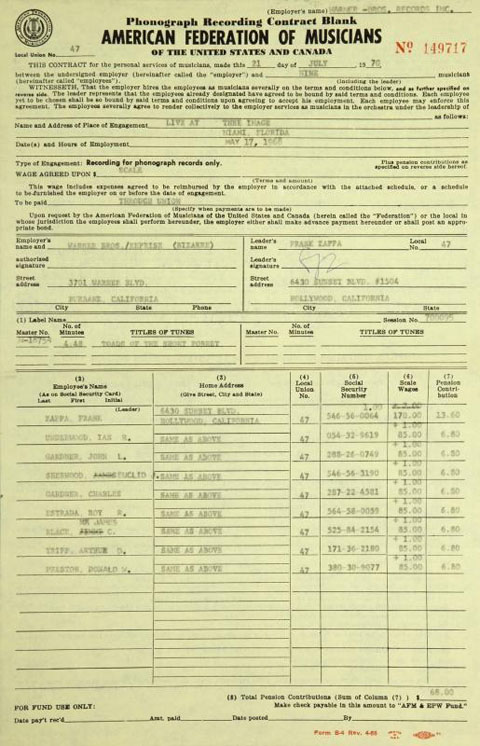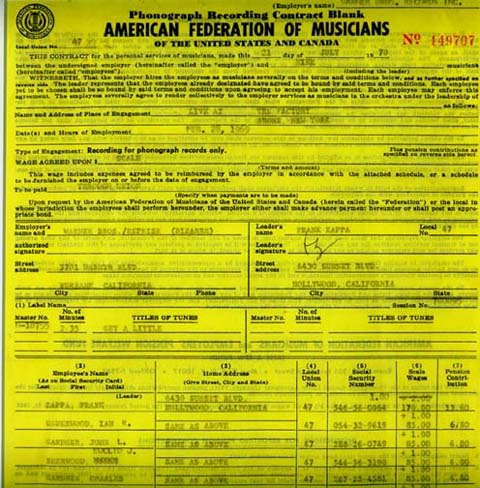Starting in 1969, Dick Kunc, who was the engineer on some of the early albums, built this little James Bond suitcase recording apparatus. He built a briefcase. He took a couple of Shure mixers, and packed it all in there, and we had a Uher, about this big, 7-1/2 ips. He accompanied us on part of the U.S. tour that year, and would sit in the corner of the room with earphones on and try to do a mix on whatever we were doing. I mean, it was impossible, but there are tapes. The first volume of You Can't Do That Onstage was mostly that. Those kind of tapes from the 1969 band.
About 1968 or '69, before the first bunch of guys broke up, we had an engineer that used to travel with us, named Dick Kunc. He had this little mixing board in a briefcase, four or five microphones, and a Uher recorder, and we used to go around and make live recordings with that.
There was one amazing road recording experience, I think it was 1969. The Mothers were going on an East-coast tour, and those of us who were not going, which included me, drove everybody else to L.A. airport. A couple days went by and I got a call from Frank saying, "I've changed my mind, I want you to come and record the rest of this tour." I said, "Frank, you may not have noticed but we don't have any equipment!" He said, "I know—just buy what you need and put it together." To him it was buy a screwdriver and a pair of pliers and that's it—you're off, what else do you need? So he said, "Fly to Miami. Herbie will take care of all the financing—just tell what you need. Fly to Miami and buy all the stuff—assemble it into a recording package, and we'll meet you there and you'll go on the rest of the tour with us."—which was by bus.
So off I went to Miami, which was my old stomping ground so that wasn't too bad. In Miami I bought a Uher five-inch-reel battery-operated two-track stereo with a one-piece stereo microphone which we used on the road a lot, mainly on the bus and in all those hotels and motels. You need to ask Bunk Gardner about an epic field recording he made with it in Miami with the help of a nurse named Peggy, a work entitled "Right There, Bunk!" Anyway, it was an amazing little machine. Many miles of recordings done on that machine ended up in various albums—the quality was that good!
For Monitoring I bought a Dynaco preamp and a Dynaco power amp, which were kits, so I had to build them. I also bought some KLH-6 speakers which were in vogue at the time, a couple of Shure mixers, and about ten microphones ranging from some medium-priced Sony condensers down to a bunch of Shure and various other brand dynamics. It was a selection designed to handle everything from vocals to bass drums.
I flew to Miami and bought all this stuff, plus a few basic tools with which to build it. I took it all to my motel room and over the next two days I built all the Dynaco kit stuff. No way to test it, of course; it just had to be right.
Now the one missing ingredient was a microphone cable "snake" that would reach from whatever back room I would be in, out onto the stage where we'd place our microphones. So I bought a ton of shielded balanced cable, Belden 8451 I think it's called, and made a snake that accommodated ten microphones—the whole thing being a hundred feet long. So that's a total of ten one-hundred-foot lengths of cable with Cannon connectors on both ends—a lot of cutting and a lot of soldering. All this measuring out the ten one-hundred-foot lengths had to be done in my dinky little hotel room, and of course there were none of those nice nylon cable ties to bundle it all together. I ended up lacing the ten lines together with string, which worked great but looked like something done by a stoned marionette. With this instant portable studio we recorded whole concerts in Miami, Philadelphia, the Fillmore East, Boston, Yale in Connecticut—a whole bunch of cities. That tour went from city to city on a Greyhound bus driven by a guy named Jake. He was the company's "stunt driver" and had made some TV spots doing "donuts" with a Greyhound SemiCruiser! Jake was cool. He fit right in, and we were glad to have him along. But that's another story.




